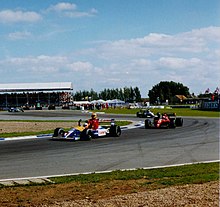This article needs additional citations for verification. (February 2015) |

A victory lap (also lap of honor) is a term used in motorsports to describe an extra lap of the race track after the conclusion of a race. This lap, driven at reduced speed, allows the winning driver to celebrate their victory and gives the spectators an opportunity to congratulate and honor the competitors. Commonly, trackside flag marshals will wave their flags in a gesture known as the FIA salute or the Monkey Dance in the US.[citation needed] It is not uncommon for marshals to clap or wave their hands at drivers as a gesture and sometimes the drivers wave back in response.
Victory laps can sometimes become dangerous for the winner and the other drivers, since in many tracks the safety nets can be easily climbed over by the crowd, which then becomes an obstacle for the racers.[citation needed]
Victory laps have regularly seen drivers who have retired in the final stages of a race being given a lift back to the pits on one of their competitors' cars. Some notable examples in Formula One include Riccardo Patrese and Didier Pironi at the 1982 Monaco Grand Prix, Nigel Mansell and Ayrton Senna at the 1991 British Grand Prix (pictured), Jean Alesi and Michael Schumacher at the 1995 Canadian Grand Prix, Michael Schumacher and Giancarlo Fisichella at the 1997 German Grand Prix, Mika Häkkinen and David Coulthard at the 2001 Spanish Grand Prix, and Mark Webber and Fernando Alonso at the 2011 German Grand Prix and 2013 Singapore Grand Prix and Sebastian Vettel and Pascal Wehrlein at the 2017 Malaysian Grand Prix.
Since the mid-2000s, the FIA, motorsports' global governing body, has restricted what a Formula One driver may do on his victory lap. The sporting regulations state that at the end of a race, "all cars must proceed on the circuit directly to the post race parc fermé without stopping, without overtaking (unless clearly necessary), without receiving any object whatsoever and without any assistance (except that of the marshals if necessary)", although this rule has rarely been enforced, such as Felipe Massa taking a Brazilian flag following his victory at the 2006 Brazilian Grand Prix, and more recently Lewis Hamilton taking a British flag following his controversial victory at the 2021 British Grand Prix.[1] It is also commonplace to see drivers overtaking on the victory lap, as well as drivers stopping to conserve a one-litre fuel sample required for post-race inspection, amongst other reasons.
- ^ "2006 Formula One Sporting Regulations" (PDF). www.fia.com. Paris, France: Fédération Internationale de l'Automobile. 8 March 2006. p. 27. Archived from the original (PDF) on 8 April 2006. Retrieved 23 October 2006.